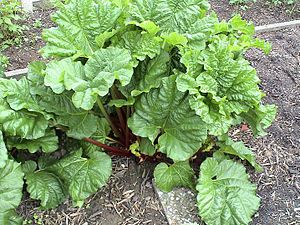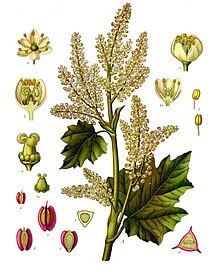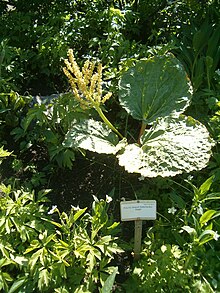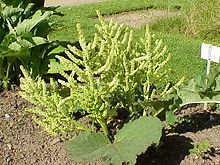Rhubarb (genus)
| rhubarb | ||||||||||||
|---|---|---|---|---|---|---|---|---|---|---|---|---|

Cultivar of rhubarb ( Rheum × hybridum ) |
||||||||||||
| Systematics | ||||||||||||
|
||||||||||||
| Scientific name | ||||||||||||
| Rheumatism | ||||||||||||
| L. |
Rhubarb ( Rheum ) is a genus of plants in the knotweed family (Polygonaceae). It is widespread in Asia.
description



Appearance and leaves
Rheumatism species grow as perennial herbaceous plants . They form thick, underground rhizomes as survival organs. The squat roots are long. The very short to long stem is erect, often hollow, smooth or furrowed and hairless or hairy. The differently shaped trichomes are an important determinant.
The alternate leaves are basal rosetters and often arranged on the stem, whereby the basal leaves are much larger than the stem-like ones. The typical feature of the subfamily, the Ochrea , is a membranous to dry-skinned, tubular sheath on the base of the petiole, which is formed by the overgrown stipules , it is relatively large with a smooth edge in most rheumatoid species. The often long petiole is fleshy. The large, simple leaf blade is wavy, toothed or lobed in the shape of a hand. There is a hand-shaped leaf vein.
Inflorescences and flowers
The inflorescence stem is articulated. One or more upright total inflorescences are formed, which are simple or branched and mostly panicley , less often spiked or spherical and in which the flowers stand together in cluster-shaped coils (partial inflorescences). The tuft-shaped wraps each stand over an ochrea.
The relatively small flowers are hermaphroditic or often unisexual. If unisexual flowers are present, then the species are polygamo-monoecious . There are two circles with three bracts each, either they are the same for both circles or those of the outer circle are slightly larger; they can be free or grown together at their base. The bracts are also preserved on the fruit. The mostly nine, rarely seven or eight stamens are fused on a ring with the bloom cladding sheets. Most three carpels are a top permanent ovary grown. The usually three short styles are horizontal and end in back-curved, inflated scars .
Fruits and seeds
The mostly triangular fruit is mostly triangular or triangular. The wings are very different in size and color depending on the species. The seeds contain a straight embryo with two broad cotyledons ( cotyledons ).
etymology
The German name rhubarb is derived from the Latin rhabarbarum (also reubarbarum ) in reference to a rheum species that has been sourced from the Black Sea coast since antiquity - probably Rheum rhaponticum L. In the past, the term was traced back to "Rha", an old name of the Volga , as the main growing area of the plant is said to have been at the mouth of the Volga.
Systematics and distribution
The genus Rheum was established in 1753 by Carl von Linné in Species Plantarum , 1, pp. 371-372. The lectotype was Rheum rhaponticum L. in 1929 by Hitchcock in Prop. Brit. Bot. , 151 set. The generic name Rheum is derived from the Greek word rheon . This name was already used by Dioscorides as a plant name, probably for the Rheum rhaponticum L. ("Pontic rhubarb") described by him, whose rhizomes were obtained in antiquity from the coastal countries of the Black Sea , perhaps also another type of rheum . The genus Rheum belongs to the tribe Rumiceae in the subfamily Polygonoideae within the family Polygonaceae .
Many of the rheumatoid species are difficult to distinguish morphologically , and they also tend to hybridize and so specimens are often wrongly identified even in botanical gardens. The genus Rheum is divided into about eight sections; Molecular genetic and chemotaxonomic studies show that the integration of the species into the sections has to be reworked. The cultivars of the cultivated rhubarb ( Rheum × hybridum ) are hybrids with different species as parents.
The Rheum TYPES exhibit areas in temperate and subtropical regions of Asia on. They mainly thrive in mountainous areas and deserts of the Qinghai - Tibetan Plateau and neighboring areas. There are about 38 species in China, 19 of them only there.









There are about 60 species in the genus Rheum (here with information on their occurrence):
- Rheum acuminatum Hook. f. & Thomson (Syn .: Rheum orientalixizangense Y.K.Yang, JKWu & Gasang ): It is widespread from India , Kashmir , Bhutan , Nepal , Sikkim Myanmar to Tibet and in the Chinese provinces of southern Gansu , Sichuan and Yunnan .
- Rheum alexandrae Batalin : It thrives on slopes at altitudes of 3,000 to 4,600 meters in the Chinese provinces of western Sichuan, northwestern Yunnan and eastern Tibet.
- Rheum altaicum Losinsk. : It comes in Kazakhstan , Mongolia , Altai , Russia,and northern Xinjiang . In Xinjiang, it thrives in forests and valleys at altitudes from 1900 to 2400 meters.
- Emodi rhubarb ( Rheum australe D.Don , Syn .: Rheum emodi Wall. Ex Meisn. ): It is widespread from India, Pakistan , Nepal, Sikkim to Myanmar and Tibet. The drug rheum emodi root is extracted from it.
- Rheum compactum L .: It is native to Kazakhstan, Russia's Far East and Siberia as well as northern Xinjiang . In Xinjiang it thrives on slopes at altitudes of around 2000 meters.
- Rheum darwazicum V.S. Titov ex Losinsk. : It only occurs in Tajikistan .
- Rheum delavayi Franch. : It occurs in Bhutan, Nepal and the Chinese provinces of western Sichuan and northern Yunnan.
- Rheum fedtschenkoi Maxim. ex rule : It only occurs in Tajikistan.
- Rheum forrestii Diels : It only thrives on slopes at altitudes of around 3000 meters in Tibet and in Sichuan and Yunnan.
- Rheum glabricaule Sam. : This endemic thrives between rocks at altitudes of 3000 to 3500 meters only in Gansu .
- Rheum globulosum Gage : It occurs only in Sikkim and in central and southern Tibet. In Tibet it thrives on slopes at altitudes between 4500 and 5000 meters.
- Rheum hotaoense C.Y.Cheng & TCKao : It thrives on slopes and gullies at altitudes of 1000 to 1800 meters in Gansu, Shaanxi and Shanxi .
- Cultivated rhubarb or garden rhubarb ( Rheum × hybridum Murray , Syn .: Rheum × cultorum Thorsrud & Reisaeter nom. Nud., Rheum rhabarbarum auct., Rheum rhaponticum auct.): Cultivated rhubarb is a hybrid that involves several species and which was bred from the 18th century.
- Rheum inopinatum Prain : This endemic thrives on slopes at altitudes of 4000 to 4200 meters only in central and southern Tibet.
- Rheum kialense Franch. : It thrives on slopes and in forests at altitudes of 2800 to 3900 meters in Gansu , Sichuan and Yunnan.
- Rheum korshinskyi V.S. Titov ex Losinsk. : It only occurs in Tajikistan.
- Rheum laciniatum Prain : This endemic thrives on hills at altitudes of around 3000 meters only in northern Sichuan.
- Rheum lhasaense A.J.Li & PGXiao : This endemic thrives on grassy slopes at altitudes of 4200 to 4600 meters only in the vicinity of the Tibetan Lhasa .
- Rheum likiangense Sam. (Syn .: Rheum ovatum C.Y.Cheng & TCKao ): It thrives in forests and on shrubby meadows at altitudes of 2500 to 4000 meters in eastern Tibet, southwestern Sichuan and northwestern Yunnan.
- Rheum lucidum Losinsk. : It only occurs in Tajikistan.
- Rheum lobatum Losinsk. : It only occurs in Kyrgyzstan .
- Rheum macrocarpum Losinsk. : It only occurs in Kyrgyzstan.
- Rheum macropterum Mart. ex Meisn.
- Rheum maculatum C.Y.Cheng & TCKao : It occurs only in Sichuan.
- Rheum maximowiczii Losinsk. : It is common in north-eastern Afghanistan, Kyrgyzstan, Tajikistan and eastern Uzbekistan .
- Rheum moorcroftianum Royle : It is common in the Himalayas . It thrives in Nepal at altitudes between 3600 and 4400 meters. In central and western Tibet, it thrives on the banks of flowing waters at altitudes between 4500 and 5300 meters. There are also occurrences in Afghanistan, India, Pakistan and eastern Tajikistan .
- Rheum nanum Siev. ex Pall. (Syn .: Rheum cruentum Sievers ex Pallas , Rheum leucorrhizum Pallas ): It is common in Kazakhstan , Mongolia, western Siberia and the Chinese provinces of Gansu , central and western Nei Mongol and northeastern Xinjiang .
- Rheum nobile hook. f. & Thomson : The distribution area extends from Afghanistan via India, Pakistan, Bhutan, Nepal, Sikkim and Myanmar to southern Tibet. In Tibet it thrives on slopes at altitudes of 4,000 to 4,800 meters.
- Rheum officinale Baill. : It occurs in the Chinese provinces of Guizhou, Henan, Hubei, Shaanxi, Sichuan, Yunnan and perhaps also Fujian at altitudes of 1200 to 4000 meters.
- Rheum palaestinum Feinbrun : It thrives in mountainous desert areas in Palestine , Israel and Jordan .
- Rheum palmatum L. , Syn .: Rheum potaninii Losinsk. , Rheum qinlingense Y.K.Yang, JKWu & DKZhang , Rhabarbarum palmatum Moench , Handlappiger Rhubarb, Medicinal rhubarb: With two or three varieties in Tibet and in the Chinese provinces of Gansu, Hubei , Nei Mongol, Qinghai , Shaanxi , Sichuan and Yunnan. There it thrives on slopes and in valleys at altitudes of 1500 to 4400 meters. In Italy he is a neophyte. It is grown in the European part of Russia. The roots and rhizomes are used medicinally and the drug is called Rhei radix = rhubarb root. The real Chinese rhubarb was only identified in the 1870s as Rheum palmatum L. (medicinalrhubarb) after cultivated seeds that the Russian geographer and explorer of Central Asia Nikolai Mikhailovich Prschewalski brought from China to Saint Petersburg . Johann August Carl Sievers tried in vain toprovide this evidence in1789.
- Rheum plicatum Losinsk. : It only occurs in Kyrgyzstan.
- Rheum pumilum Maxim. : It thrives on slopes at altitudes of 2800 to 4500 meters in Gansu, Qinghai , Sichuan and Tibet.
- Rheum racemiferum Maxim. : It occurs in China and maybe Mongolia. In Gansu , Nei Mongol and Ningxia , it thrives on slopes and grasslands at altitudes of 1300 to 2000 meters.
- Common rhubarb or curly-leaved rhubarb ( Rheum rhabarbarum L. , Syn .: Rhabarbarum verum Garsault , Rheum franzenbachii Münter , Rheum franzenbachii var. Mongolicum Münter , Rheum undutalum L. , Rheum undulatum var. Longifolium C.Y.Cheng & TCKao ): from eastern Siberia via Mongolia to the Chinese provinces of Hebei , Heilongjiang , Hubei , Jilin , Nei Mongol and Shanxi . It is one of the species from which the garden rhubarb was bred.
- Rhapontic rhubarb or Siberian rhubarb ( Rheum rhaponticum L. , Rheum esculentum Salisb. , Rheum rotundatum Stokes , Rheum sibiricum Pall. ): It occurs in southern Norway and southern Siberia. The occurrence in southwestern Bulgaria is likely to be plants that were overgrown from culture a long time ago. It is eaten and used as a medicinal plant. The drug is called Rhei rhapontici radix and is used to treat menopausal symptoms.
- Rheum rhizostachyum Schrenk : It occurs in Kazakhstan and Xinjiang. In Xinjiang it thrives on slopes at altitudes of 2600 to 4200 meters.
- Rheum rhomboideum Losinsk. : This endemic thrives on slopes and grasslands at altitudes of 4700 to 5400 meters in central and eastern Tibet.
- Rheum ribes L .: The distribution area extends from northern Pakistan and Afghanistan via Azerbaijan , Iran and northern Iraq , Lebanon , Syria to eastern Turkey .
- Rheum rupestre Litv. ex Losinsk. : It occurs in Azerbaijan and Turkmenistan .
- Rheum spiciforme Royle (Syn .: Rheum scaberrimum Lingelsheim ex Limpricht , Rheum przewalskyi Losinsk. ): It is common in Afghanistan, Kashmir , Pakistan, Bhutan, Sikkim, in western Tibet and the Chinese provinces of Gansu, Qinghai and northwestern Sichuan.
- Rheum subacaule Sam. : This endemic thrives on mountain tops and on slopes at altitudes of 3500 to 4300 meters only in western Sichuan.
- Rheum sublanceolatum C.Y.Cheng & TCKao : It thrives on slopes at altitudes of 2,400 to 3,000 meters in Gansu, Qinghai and Xinjiang.
- Rheum tataricum L. f. ( Rheum caspicum Pallas , Rheum songaricum Schrenk ): It is widespread in Afghanistan, Kazakhstan, in the European part of Russia and in western Xinjiang. In Xinjiang it thrives on grasslands, deserts and plains at altitudes of 500 to 1000 meters.
- Rheum tetragonopus Mart.
- Rheum tibeticum Maxim. ex Hook. f. : It is common in Afghanistan, Pakistan, Kashmir and Tibet. In Tibet, it thrives on slopes at altitudes of 4000 to 4600 meters.
- Rheum turkestanicum Janisch. : It occurs only in Turkmenistan.
- Rheum uninerve Maxim. : It is common in Mongolia and the Chinese provinces of Gansu, Nei Mongol and eastern Qinghai. In China, it thrives on slopes and roadsides at altitudes of 1100 to 2300 meters.
- Rheum webbianum Royle : It iswidespreadin northwestern India , Kashmir, Pakistan, Nepal and southwestern Tibet. In Tibet, it thrives on slopes at altitudes between 3500 and 3600 meters. The roots and rhizomes are used medicinally.
- Rheum wittrockii C.E. Lundstr. : It is common in Kazakhstan, Kyrgyzstan and Xinjiang. In Xinjiang it thrives on grassy slopes, in forests and gullies at altitudes of 1200 to 2600 meters.
- Rheum yunnanense Sam. : It occurs in Myanmar and northwestern Yunnan.
use
Species used by humans (selection): The garden rhubarb or common rhubarb ( Rheum × hybridum ), the rhubarb that is grown as a vegetable in the garden, is a relatively young form of culture that has been bred since the 18th century. It only became a common foodstuff with the advent of inexpensive sugar. There are several types of it.
The common rhubarb is grown as a useful plant on all populated continents in suitable climatic zones. A special form of rhubarb cultivation is used for Yorkshire Forced Rhubarb . Other species were spread by humans for their medicinal uses or as ornamental plants .
Some types of rhubarb have a long history of use as medicinal plants. Chinese rhubarb or medicinal rhubarb ( Rheum officinale ) has been used as a medicine in China for around 4000 years . The doctors in Arabia and Persia in the early period made frequent use of the palm-shaped rhubarb ( Rheum palmatum L.), the crown rhubarb, the medicinal rhubarb or the Tangut rhubarb ( Rheum palmatum ). The rhubarb root (Radix Rhei) is still used today in pharmacy as a mild laxative.
The tanning agents contained in the "root stock" are being examined for their suitability as an alternative tanning agent as a natural, environmentally friendly alternative to, for example, toxic chromium compounds .
The root parts, crushed to a pulp, can be used as a natural hair dye or similar to henna (red dye ).
As plant protection agents one can a rhubarb (the parts of plants Rheum × hybridum used) through the plant lice are distributed.
ingredients
The leaves of all rhubarb species and varieties contain oxalic acid ; for health concerns, see common rhubarb .
Roots and stems also contain anthraquinones such as Emodin and Rhein . Both have an expectorant and laxative effect. Their yellow or orange color stains the urine. In addition, hair can be tinted with these anthraquinones.
mythology
In Persian mythology, the first pair of humans, Marshyak and Marshyanak, grew from a rhubarb plant ( rêwena ) in nine months , with their hands on their ears. The myth here probably alludes to the fact that the root of a rhubarb plant can resemble a human body or two in shape.
swell
- Bao Bojian (包 伯 坚), Alisa E. Grabovskaya-Borodina: Rheum, pp. 341–346: Rheum - Online. In: Wu Zhengyi, Peter H. Raven, Deyuan Hong (Eds.): Flora of China. Volume 5. Ulmaceae through Basellaceae . Science Press et al., Beijing et al. 2003, ISBN 1-930723-27-X . (Section Description and Occurrence)
- M. Qaiser: Polygonaceae. Rheumatism in the Flora of Pakistan . (Section description)
- Craig C. Freeman: Rheumatism : Rheumatism - Online. In: Flora of North America Editorial Committee (Ed.): Flora of North America North of Mexico. Volume 5. Magnoliophyta: Caryophyllidae, part 2. Oxford University Press, New York et al. 2005, ISBN 0-19-522211-3 . (Section description and generic name)
- Rheumatism. In: Rudolf Hänsel, Konstantin Keller, Horst Rimpler (eds.): Hager's handbook of pharmaceutical practice. Volume 6. Rudolf Hansel: Drugs PZ. Springer, 1994, ISBN 3-540-52639-0 , pp. 411-439. (Google-Books-Online) (Used for notes on usage)
- Ailan Wang, Meihua Yang, Jianquan Liu: Molecular Phylogeny, Recent Radiation and Evolution of Gross Morphology of the Rhubarb genus Rheum (Polygonaceae) Inferred from Chloroplast DNA trnL-F Sequences. In: Annals of Botany. Volume 96, Issue 3, 2005, pp. 489-498. (Section distribution and systematics)
- Xu-mei Wang, Xiao-qi Hou, Yu-qu Zhang, Yan Li: Distribution pattern of genuine species of rhubarb as traditional Chinese medicine. In: Journal of Medicinal Plants Research. Volume 4, Issue 18, 2010, pp. 1865–1876. ISSN 1996-0875 . PDF .
- Joseph C. Kuhl, Veronica L. DeBoer: Genetic Diversity of Rhubarb Cultivars. In: Journal of the American Society for Horticultural Science. Volume 133, Issue 4, 2008, pp. 587-592. PDF .
Individual evidence
- ↑ a b c d Rudolf Hansel: Rheum . In: Rudolf Hänsel, Konstantin Keller, Horst Rimpler (eds.): Hager's handbook of pharmaceutical practice. Drugs PZ. tape 6 . Springer, 1994, ISBN 3-540-52639-0 , pp. 411–439 ( Rheum on p. 411–439 in the Google book search).
- ↑ The species Rheum rhabarbarum L. was not imported into Europe from Central Asia or China until the Middle Ages.
- ↑ Ruth Spranger: Master Nikolaus von Frankenfurt and his rhubarb treatise. A side note on the 'Breslau Pharmacopoeia'. In: Würzburger medical history reports 17, 1998, pp. 175–179; here: p. 175.
- ↑ First publication scanned at biodiversitylibrary.org .
- ^ Rheumatism at Tropicos.org. Missouri Botanical Garden, St. Louis
- ↑ Ruth Spranger: Master Nikolaus von Frankenfurt and his rhubarb treatise. A side note on the 'Breslau Pharmacopoeia'. In: Würzburger medical history reports 17, 1998, pp. 175–179; here: p. 175.
- ↑ Irmgard Müller: Rhubarb. In: Lexikon des Mittelalters , VII (1995), column 780.
- ^ A b c Rheum in the Germplasm Resources Information Network (GRIN), USDA , ARS , National Genetic Resources Program. National Germplasm Resources Laboratory, Beltsville, Maryland.
- ↑ a b c d e f g h i j k l m n o p q r s t u v w x y z aa Bao Bojian (包 伯 坚); Alisa E. Grabovskaya-Borodina: Rheum Linnaeus. - Same text online as the printed work , In: Wu Zheng-yi, Peter H. Raven, Deyuan Hong (Ed.): Flora of China. Volume 5: Polygonaceae. Science Press and Missouri Botanical Garden Press, Beijing and St. Louis 2010
- ↑ http://www.arzneipflanzenlexikon.info/rhabarber.php
- ↑ Mircea Eliade: History of Religious Ideas. Vol. 2: From Gautama Buddha to the beginnings of Christianity. Freiburg: Herder, 1979, p. 272.
- ↑ Paolo Delaini: The Strange Case of the Plant Rivas . How the Middle-Persian Tree of Life Became the Protagonist of an Episode of Austrian History, p. 59. In: Maria Macuch, Dieter Weber, Desmond Durkin-Meisterernst (Hrsg.): Reprint from Andienct and Middle Iranian Studies. Proceedings of the 6th European Conference of Iranian Studies, held in Vienna, September 18-22, 2007. Wiesbaden: Harrassowitz, 2010, pp. 53-61.
